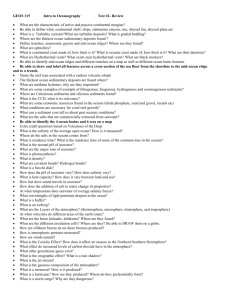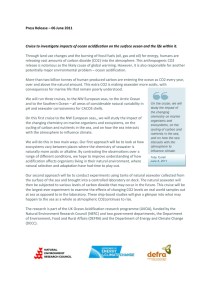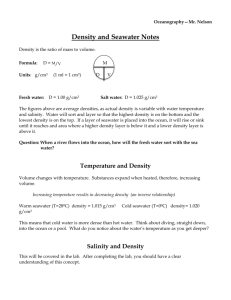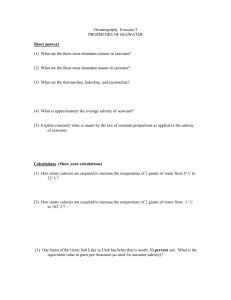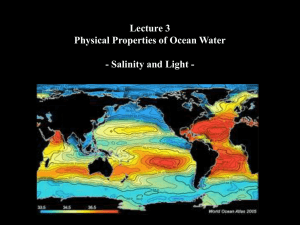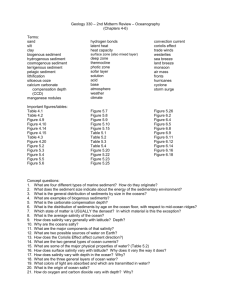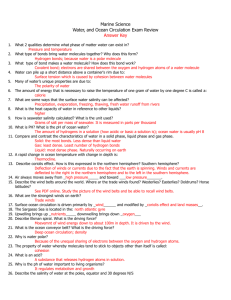Ocean Chemistry
advertisement
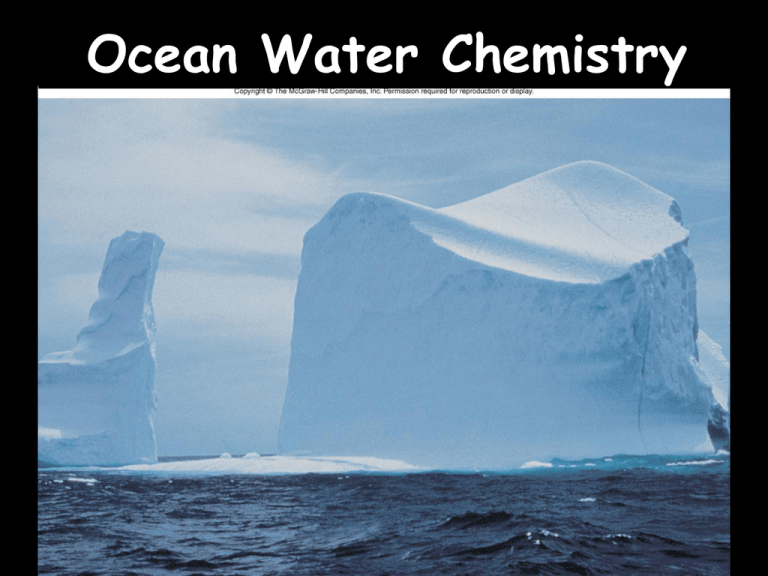
Ocean Water Chemistry Figure 4.17a http://www.nhptv.org/ Distribution of Earth’s Water • • • • • • Oceans Ice Caps and Glaciers Atmosphere Rivers and Lakes Inland Seas Groundwater 97.2 % 2.15 % 0.001 % 0.009 % 0.008 % 0.625 % Ocean Water is SALTY • Salinity: Total amount of dissolved solids • Units: o/oo = 1/1000 • Range: 33 – 37 o/oo • Increase in salinity: – – – – Increase in Density Decrease in Freezing Point Decrease in Vapor Pressure Increase in Osmotic Pressure Origin of Salts in Oceans • Rivers (largest transport of chemicals to ocean) – Rain + CO2 H2CO3 – Si, Al, Na, K, Mg • Volcanoes – Cl, S, CO2 • Dust / Rain – Fe, Si • Anthropogenic – CO2, P Example Geochemical Cycle Concept of Steady State Example 2 Geochemical Cycle Residence Time (T = Ocean amount/Output rate) • Concentration of elements in seawater is determined by their removal rate • Conservative elements: – Major Elements: Cl, Na, SO4, Mg, Ca, K - Minor Elements: Br, Sr, B, C, F • Non Conservative Elements – Nutrients: N, P, Si – Dissolved gases: O2, CO2, N2 – Trace Elements: Fe, Al, Mn – Organic Compounds Residence Time - Concentration Element Res. Time (yrs) Concentration Crust (%) Ocean (mg/l) Na Cl Mg K SO4 Ca Mn Fe 60 000 000 80 000 000 10 000 000 6 000 000 9 000 000 1 000 000 7 000 100 2.4 0.013 2.3 2.1 0.026 4.1 0.5 2.4 10 770 19 500 1 290 380 905 412 0.0002 0.002 Dissolved Gases Gas Solubility: Decreases with Temp. and Salinity Increases with Pressure Gases in Atmosphere & Oceans Percent Gas Phase by Volume Gas Atmosphere Surface Ocean Total Ocean N2 79% 48% 11% O2 21% 36% 6% CO2 0.04% 15% 83% Seawater pH • Pure water pH = 7 • Seawater pH = 7.5 – 8.1 • Seawater is very well buffered! CO2(gas)+H2OH2CO3H++HCO32H++CO32 H2O: Universal Polar Solvent H20: Temperature and Density H2O: Frozen & Liquid density H2O: Heat Capacity • Heat Capacity: heat needed to change the temperature of a substance • Water has higher heat capacity than: – All solids – All liquids, except liquid ammonia • Latent heat of Vaporization: heat needed to evaporate a liquid – Water has the highest of all substances Seawater: Temperature and Density Seawater: Temperature and salinity Seawater: Ice Formation Electromagnetic wave penetration Open water (low productivity) Coastal and Estuarine waters (high productivity) Nuclear Missile Submarine http://www.nhptv.org/ How do we measure light penetration? Secchi Disc Water Refraction Eschrichtius robustus Sound Velocity • Influenced by Salinity, Temperature and Pressure – Increases with Salinity – Increases with Temperature – Increases with Pressure • Concept of Midwater Sound Channel Study in Detail Fig 5-19! Sound Channel Humpback Whales Megaptera novaeangliae Gray Whale & Sonar Proposal Eschrichtius robustus Gray Whale Migration Acoustic Pollution

